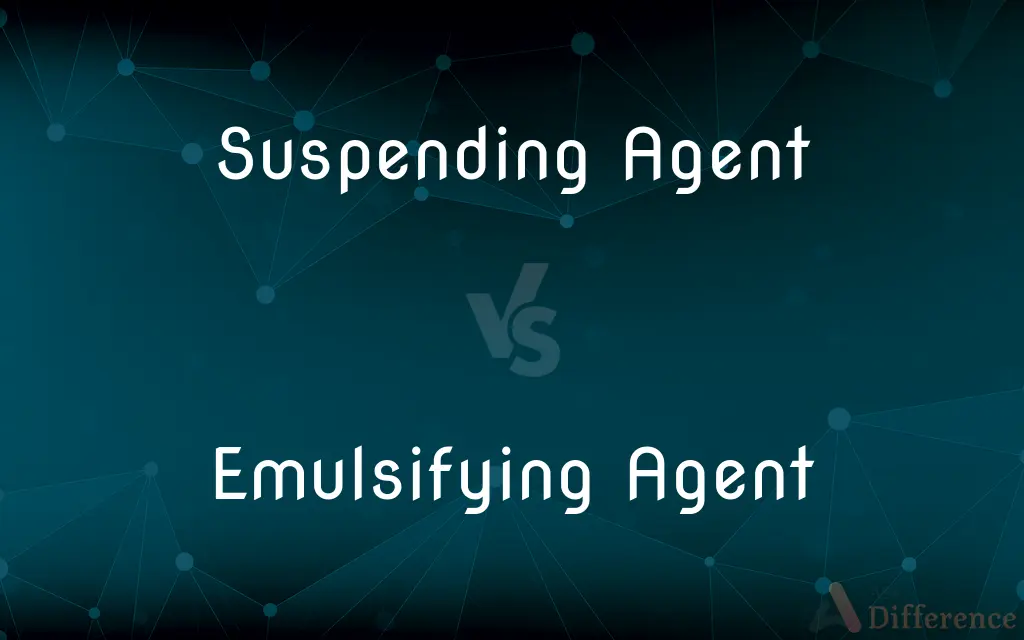Suspending Agent vs. Emulsifying Agent — What's the Difference?
By Tayyaba Rehman — Published on December 23, 2023
Suspending Agent helps distribute and maintain particles in a medium, preventing sedimentation. Emulsifying Agent stabilizes a mixture of two immiscible liquids, like oil and water.

Difference Between Suspending Agent and Emulsifying Agent
Table of Contents
ADVERTISEMENT
Key Differences
A Suspending Agent typically functions to evenly disperse and sustain particulate matter throughout a liquid medium, ensuring that sedimentation or settling of particles is minimized or delayed. This property is vital in various industries, including pharmaceuticals and food, where uniform distribution of components within a liquid is pivotal. Suspending Agents essentially ensure that the distributed particles remain suspended for an optimal period of time, enabling consistency in texture and quality.
Conversely, an Emulsifying Agent works to stabilize a blend of two or more immiscible liquids, establishing a stable emulsion where one liquid is dispersed in another in the form of tiny droplets. A classic example is the stabilization of oil droplets within water, a mechanism prevalent in numerous products like mayonnaise and lotions. The Emulsifying Agent prevents the separated liquids from coalescing and reverting back to their individual states, preserving the integrity and uniformity of the product.
When we delve into practical applications of a Suspending Agent, it’s clear that this agent is imperative in formulations where undissolved particles need to be uniformly distributed, such as in some medicinal syrups or suspensions. By inhibiting the particles from settling at the bottom, Suspending Agents ensure that each dosage contains the intended amount of active ingredient, securing both efficacy and safety in product utilization.
On the other hand, the Emulsifying Agent finds its significance underscored in instances where a homogeneous and stable mixture of immiscible liquids is requisite. This is paramount in not only food production but also in cosmetic formulations, where a seamless blend of oils and water components is imperative to achieve the desired texture, appearance, and performance of the product, ensuring consumer satisfaction and product reliability.
To encapsulate, while the Suspending Agent is paramount in maintaining the suspension of particles within a medium, ensuring even distribution and preventing rapid sedimentation, the Emulsifying Agent is crucial in formulating stable emulsions, preventing phase separation of immiscible liquids and ensuring product stability. Both agents, while facilitating stability in formulations, operate on different principles and are optimal in disparate applications, affirming their unique and distinctive roles in various industries.
ADVERTISEMENT
Comparison Chart
Primary Function
Maintains suspension of particles
Stabilizes mixtures of immiscible liquids
Common Usage
Medicinal suspensions, beverage
Mayonnaise, creams, lotions
Role in Formulation
Prevents sedimentation of particles
Prevents phase separation of liquids
Stability Type
Particle stability within a medium
Stability of emulsions
Particle/Liquid Nature
Particles suspended in a liquid
Immiscible liquids mixed together
Compare with Definitions
Suspending Agent
Essential for certain medicinal formulations.
The Suspending Agent in the cough syrup ensured consistent doses.
Emulsifying Agent
Pivotal for consistent product texture.
The Emulsifying Agent was vital for achieving the lotion’s silky feel.
Suspending Agent
Ensures consistent product efficacy.
Inclusion of a Suspending Agent guaranteed stable active ingredient distribution in the suspension.
Emulsifying Agent
Integral for certain culinary applications.
The mayonnaise used an Emulsifying Agent to prevent separation of ingredients.
Suspending Agent
Enhances product texture and quality.
Using a Suspending Agent kept the spices mixed throughout the sauce.
Emulsifying Agent
Stabilizes mixtures of immiscible liquids.
The Emulsifying Agent kept the oil and water blended in the dressing.
Suspending Agent
Maintains uniform particle dispersion.
Thanks to the Suspending Agent, the medicine had no sediments at the bottom.
Emulsifying Agent
Employed in various industrial applications.
In cosmetic production, an Emulsifying Agent ensured stable formulations.
Suspending Agent
Prevents particle sedimentation.
The Suspending Agent ensured the glitter stayed evenly dispersed in the nail polish.
Emulsifying Agent
Prevents phase separation in products.
Utilizing an Emulsifying Agent, the cream maintained a smooth texture.
Common Curiosities
Does a Suspending Agent influence product texture?
Absolutely, it helps maintain a consistent texture.
What is the primary function of a Suspending Agent?
It maintains the suspension of particles within a medium.
Can a Suspending Agent prevent particles from settling?
Yes, it prevents or delays particle sedimentation.
Can Suspending Agents alter the flavor of a product?
Most are neutral but can impact mouthfeel, affecting perceived flavor.
Is an Emulsifying Agent necessary for making mayonnaise?
Yes, it prevents the oil and water from separating.
What does an Emulsifying Agent do?
It stabilizes mixtures of two or more immiscible liquids.
Can I find Emulsifying Agents in cosmetic products?
Yes, many lotions and creams contain emulsifying agents.
Can a Suspending Agent be a solid?
Yes, certain powdered agents help suspend particles.
Is a Suspending Agent useful in pharmaceuticals?
Yes, especially in formulations like suspensions and syrups.
Are Suspending Agents safe to consume?
Generally, yes, but always adhere to specified dosages and guidelines.
Can I use any Emulsifying Agent in food products?
Only food-grade emulsifiers should be used in edibles.
Are natural Emulsifying Agents available?
Yes, eggs, mustard, and honey are examples.
Are Suspending and Emulsifying Agents the same?
No, they have distinct functions in stabilizing formulations.
What examples of Emulsifying Agents are used in baking?
Eggs and soy lecithin are common baking emulsifiers.
What are synthetic Emulsifying Agents?
Polysorbates and sorbitan esters are synthetic examples.
Share Your Discovery

Previous Comparison
Bubble Gum vs. Chewing Gum
Next Comparison
Genetic Code vs. CodonAuthor Spotlight
Written by
Tayyaba RehmanTayyaba Rehman is a distinguished writer, currently serving as a primary contributor to askdifference.com. As a researcher in semantics and etymology, Tayyaba's passion for the complexity of languages and their distinctions has found a perfect home on the platform. Tayyaba delves into the intricacies of language, distinguishing between commonly confused words and phrases, thereby providing clarity for readers worldwide.
















































